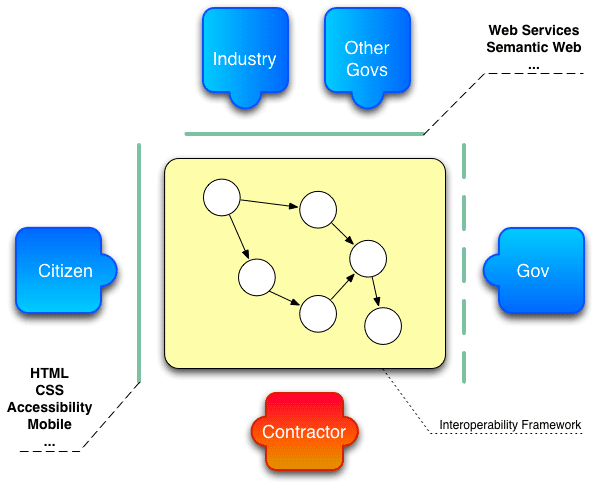One Web for Everyone
"The social value of the Web is that it enables human communication,
commerce, and opportunities to share knowledge. One of W3C's primary goals is
to make these benefits available to all people, whatever their hardware,
software, network infrastructure, native language, culture, geographical
location, or physical or mental ability."

Sir Tim Berners-Lee, W3C Director and Inventor of the
World Wide Web.
Open Standards: Big Picture
Not just a technical problem.

Open Standards Policies
- No-one should require people to purchase particular software for
access
- Promote longevity of information
- Openness helps to maximize reuse of knowledge
- colleagues, friends, public, companies, governments
- Open standards promote research
- Open standards have brought us the Internet and the Web
- Commercial Interest:

Open Standard Definition
A lot of debates nowadays for a common definition of Open Standards.
 W3C recently endorsed with fellow SDOs IEEE and IETF the Open Stand definition, aka The Modern
Paradigm for Standards:
W3C recently endorsed with fellow SDOs IEEE and IETF the Open Stand definition, aka The Modern
Paradigm for Standards:
- Cooperation among all stakeholders
- Standardization with Due process, Broad consensus, Transparency,
Balance and Openness.
- Collective Empowerment based on technical merit, on
providing global interoperability, scalability, stability, and resiliency,
and on enabling global competition, further innovation, the creation of
global communities, thus benefiting humanity.
- Availability of technology with reasonnable IPR
- Voluntary Adoption
Challenges...
- The Internet and the Web is the easy part : Web, email, forum, online
chat, IM, etc.
- Lots of non-internet technologies: telephone, fax, PDA,
SMS, MMS, RFID, biometric, smart cards, TV and radio, etc.
- New technology-specific challenges: geolocation, social,
privacy, ads, etc.
"If we can produce everything I can imagine, we will have failed. The
idea is to produce everything other people can imagine". TBL.
W3C Exec Summary
The World Wide Web Consortium (W3C) is an International Consortium
where Member and External organizations, a full-time technical staff, and the
public work together to lead the World Wide Web to its full
potential by developing Web standards such as protocols and guidelines
that ensure long-term growth for the Web.
- Goals: Interoperability, Universality,
Functionalities
- Neutral/nonforprofit, consensus based, open
participation, open results
- Legal nature: a joint partnership between several academic institutions,
funded by the private sector and some public grants.
4 Host sites: Massachusetts Institute of Technology (Boston,
Massachusetts, USA), the European Research Consortium in Informatics and
Mathematics (Sophia-Antipolis, France) and Keio University (Shonan
Fujisawa, Japan). New in 2013: a W3C host in China, at Beijang University.
- A small staff and a large
community of experts.
- Hundreth
of Members from all horizons. Thousands of Invited Experts from even
more regions and countries.
- A network of W3C Offices around the world.
W3C Process Flow
 Based on a transparent and public Process compatible with WTO
standard guidelines.
Based on a transparent and public Process compatible with WTO
standard guidelines.
Web Standards
What most people talk about:

Accountable to the Global Public
- W3C is accountable to Members and to non-Members around the
globe.
- All Working Groups maintain public Web sites and mailing lists.
- All draft standards documents available to the public at a very early
stage.
- Public-participation Interest Groups for worldwide collaboration and
community building via open email lists.
- A growing network of volunteers translators working on W3C standards and
reports and press
releases into multiple languages.
Global Standards as enablers
Substantive work in areas with the particular objective of enabling
Universal Access to the Web.
- The Web Accessibility
Initiative develops technology, guidelines, and tools to increase
accessibility of the Web for people with disabilities.
- The Internationalization Activity makes it possible and easy
to use W3C technology worldwide by breaking down barriers between the Web
and our planet's many languages, scripts,
and cultures.
- W3C's Mobile Web
Initiative aims to make Web access from a mobile device as simple and
convenient as Web access from a desktop device, critical for the developing
world.
Removing economical barriers
International Relations and Liaisons
- The Consortium maintain liaisons with over 50 national, international and regional
organizations around the globe
- IETF, ISO, IEEE, ITU, OMA, OMG, OASIS, OpenGIS, ICANN, Unicode, UN, IGF
and many others.
- Our goals:
- Improved Mutual Understanding of Web technologies
- Better Web Standards.
- More Widely Used Web Standards.
W3C and Payment
- Historical Data: JEPI, microPayment
- Current Practices
- Current W3C Initiatives
- Upcoming Workshop
Early work on Web Payments
- 1996 - JEPI - payment negotiation
- Enabling web browsers and servers to search for compatible payment solutions
- 1999 - Common Markup for micropayment per-fee-links
- Micro Payments
- IBM micropayments, iPIN, Millicent, NetBill
- Web Advertising emerges as dominant model
- Proprietary solutions for payments
- Ease of phishing as a threat to card payments
"Improved" security for card payments: 3DSecure
- Branded as Verified by VISA and MasterCard SecureCode
- User authentication and confirmation of payment in HTML IFRAME
- Users still have to enter card details and a password, facilitating phishing
- Shifting liability onto the card holder through legal loophole!
"Verified by Visa and MasterCard SecureCode: or, How Not to Design Authentication", Steven J. Murdoch and Ross Anderson, Financial Security and Cryptography, January 2010.
An increasing variety of payment solutions
- PayPal, Stripe, allpay, Tenpay, Square, Verifone SAIL, Flint, V.me, Paypass, Weve, Isis, MasterPass, Google Wallet, LevelUp, GSMA OneAPI, Mozilla mozpay API, Facebook Payments, MintChip, Bitcoin, Paymium Paytunia, Amazon Coins, CentUp, Flattr, PaySwarm, WebCredits, IFEX, Ripple, ...
- More info on these
The huge variety causes pain for users and developers alike!
Current W3C Initiatives
- W3C Team led task force on Web payments
- Web Payment Community Group
- W3C Workshop planned for early 2014
- Paris, March? Date to be finalized soon
Emerging themes
- Focus on improving usability and security
- Digital wallets that hold multiple payment solutions as well as loyalty coupons etc.
- Mix of device embedded and cloud based technologies
- Users want to access their wallet from any of their personal devices!
- Reducing the effort expected from web developers whilst give users control over how they pay
Workshop Positioning
- Is it timely to initiate work on Web payment APIs?
- Start with simple payment request API
- Browser hands over request to wallet for user to choose how to pay
- Users may be asked to to authenticate themselves and confirm payment
- Selected payment provider generates proof of payment for merchant
- Wallet and payment providers as examples of trusted system apps
- Later expand scope to offline and person to person payments
- Ensuring a level playing field for payment providers, existing and new, large and small!
- Need to be able to install new payment providers after device has shipped
Relevant existing and new standards activities
This is just a few of the relevant examples
- W3C System Applications Working Group
- Trusted system apps as alternative to native apps
- API for access to Secure Elements
- API for access to Bluetooth
- W3C NFC Working Group
- W3C WebCrypto Working Group
- Interest in location based value-added services
- Outdoors, and soon indoors ...
- Bluetooth Low Energy: PayPal Beacon, Apple iBeacon
Conclusion
- W3C: A unique combination of characteristics among Standard
organizations.
- Open standards are the future for payments, just as for the Web
- Open standards power the ecosystem creating more opportunities for innovation
- Open standards provide sustainable revenues for stakeholders
- EPASOrg can leverage the experience gained by W3C
- Greater Opportunities for Everyone!
"Tim, why did you choose www for the Web
in 1989 ?"
"I googled it and it wasn't taken"















 W3C recently endorsed with fellow SDOs IEEE and IETF the Open Stand definition, aka The Modern
Paradigm for Standards:
W3C recently endorsed with fellow SDOs IEEE and IETF the Open Stand definition, aka The Modern
Paradigm for Standards: Based on a transparent and public Process compatible with WTO
standard guidelines.
Based on a transparent and public Process compatible with WTO
standard guidelines.